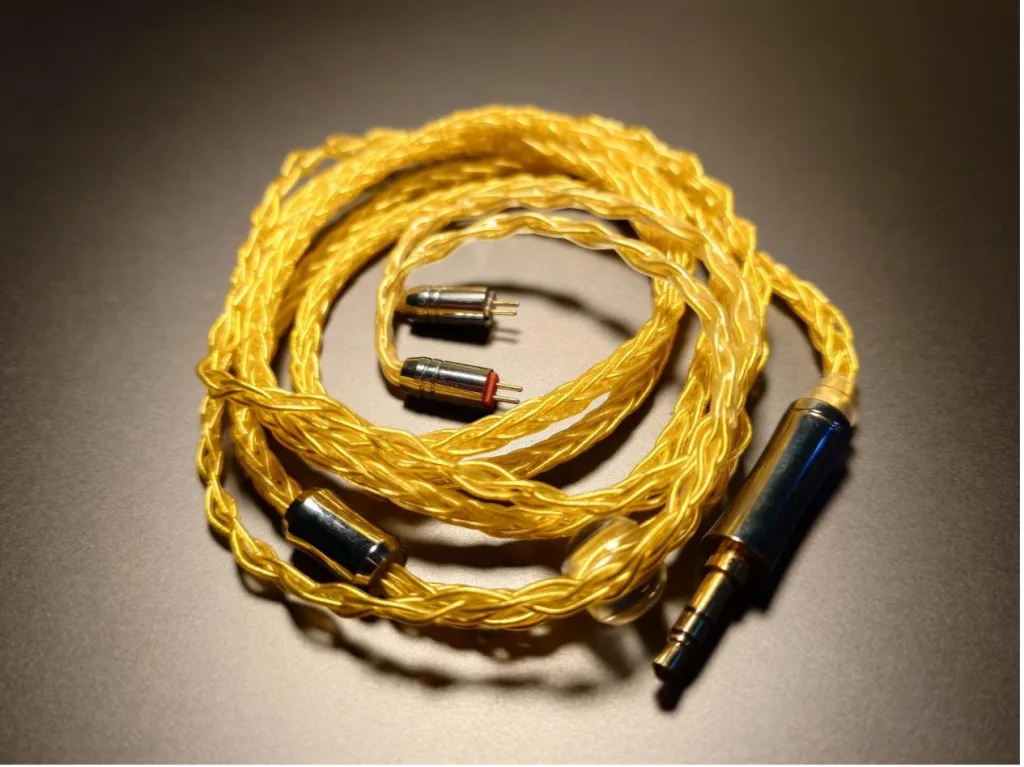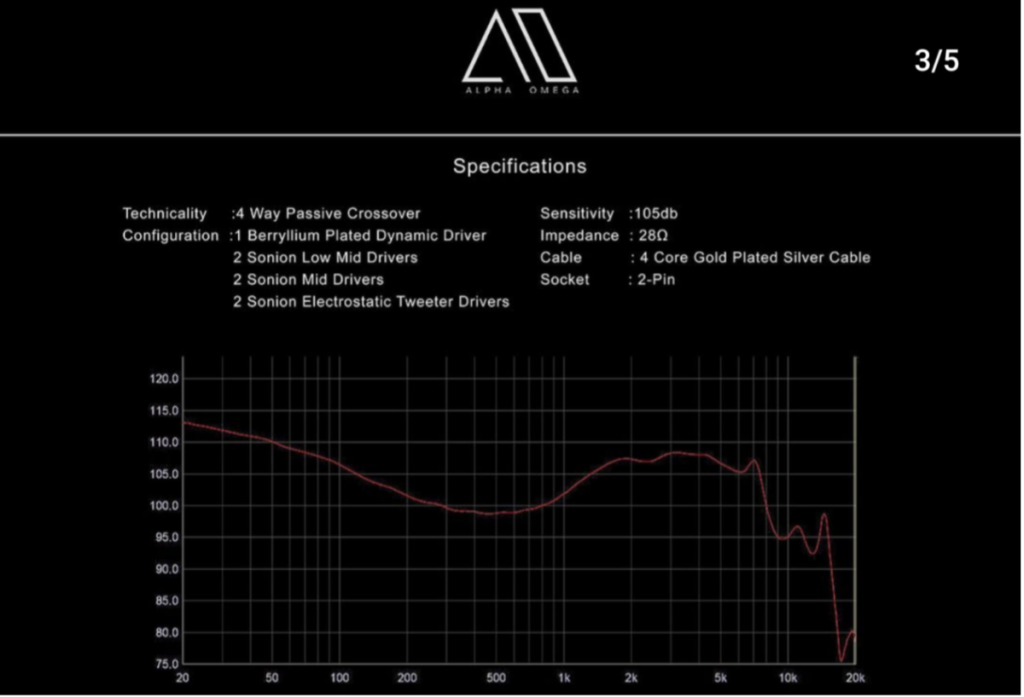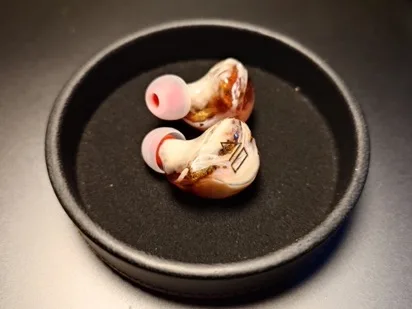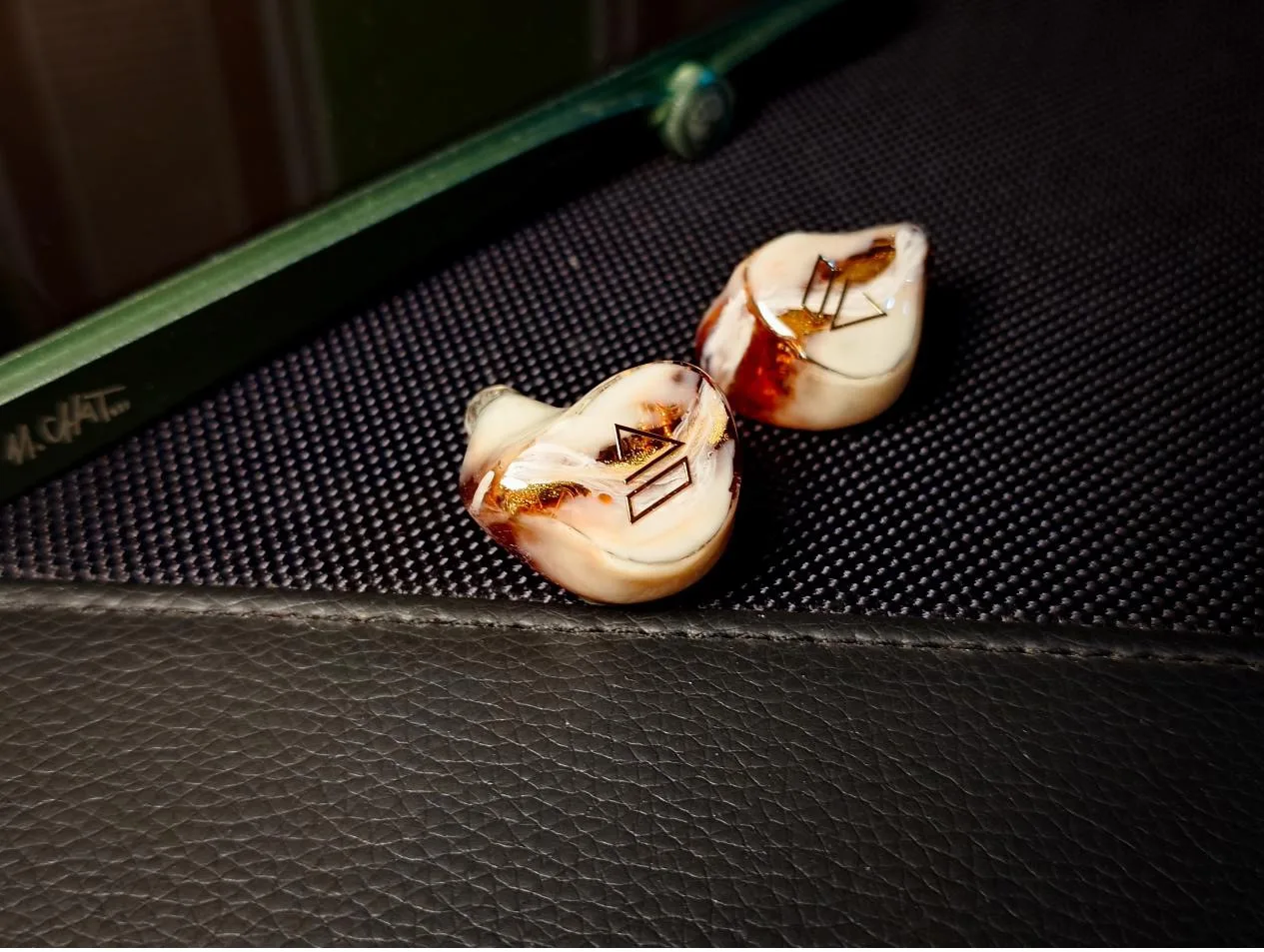Disclaimer
- The reviewed IEM is a borrowed personal unit. Regardless, all the opinions are original ideas, there is zero influence from any 3rd party or external opinions.
- No EQ or filter presets were used during the entire review period.
- Sound evaluation are kept neutral and does not include 3rd party accessories (ie; eartips, cable, reversible mods)
Introduction
Alpha Omega Custom In-Ear or better known as AO for short has enjoyed excellent spell during recent times, seeing brand new handcrafted models of custom in-ears rolling out of their production line. Entering midway during 2023 last year, AO has released four new models such as the Voyager, a collaboration project with Hillaudio Malaysia which I have covered last time. Next, was the Indomitus, followed by the continuation of their flagship sequel, Omegon MKII and lastly the latest one which I will be reviewing this time, is the Alpha Omega Ra. Every time AO released a brand new model, I cannot help myself being excited and eagerly anticipated to try out the models for myself.
Luckily, with the help of my audio buddies that I have met online, I was kindly offered to test and review the Alpha Omega Ra at my own comfort. Huge shout-out and appreciation for the kind offer. At the heart of this earpiece, AO has presented to us 7-drivers total of tribrid design for the Ra. Combining one beryllium plated dynamic-driver, 4 Sonion balanced armatures for its low-mid and midrange frequencies and lastly 2 Sonion electrostatic drivers for the treble feeded through an in-house developed 4-way passive crossover. While that may seem mouthful enough to say, this whole package comes with a price tag of only RM2668 or equivalent to US$563 (rounded-off). Hence, with that let’s get on with the review. Unboxing Experience
Unboxing Experience

Packaging of the Ra was minimal and straightforward, similar to most of AO offering in their catalog albeit midrange or flagship models. Presentation was overall basic whereby there is no such premium feature when compared to other brands. Nonetheless, what is more important is certainly what’s inside the package and the monitors itself. On the sleeve cover there is a branding logo on the front, a specification list and a diagram of the frequency response at the back. By sliding the sleeve either top or bottom unveils the main box.

Flipping the main box cover, unveils the monitor itself placed snug inside a thick foam cut out. As we explore further AO have included in the package, one custom made premium casing made from faux leather complemented with a well-padded velvet upholstery in the inside to store your monitors. Stored in the casing as well is the stock cable and 3 pairs of silicone eartips that what seems to be similar of AT07 eartips which comes in various sizes (S,M,L).
Cable

AO has certainly hit the nail on the head with the cable aesthetics, which further compliments the overall aesthetics of the Ra. In terms of the build and material, AO went to choose a 4 core, gold plated silver cable which, I reckon are SPC cables. Hands on experience using the cable was overall great, similarly to other AO monitors which I have tried in the past, such as the Lambda, Iota and Omegon MKI. The cable is insulated with a soft pliable yellowish PVC material which further radiates its golden charm. Braiding quality on this are neat and fairly secure, the connectors are made out of lightweight stainless steel. At the end of each 2-pin connectors, there are no such indication of “L” or “R” other than the plastic bit which holds the two tiny pins in red and clear.
Specifications
- Driver(s): 1 Beryllium Plated Dynamic-driver, 2 Sonion Low-mid BA, 2 Sonion Mid BA, 2 Sonion EST Drivers with 4-way Passive Crossover
- Impedance: 28 Ohms
- Sensitivity: 105dB/SPL
- Frequency Response: 10Hz-40kHz
- Cable: 4 core, gold plated silver cable, 2-pin (0.78mm) to 3.5mm connectors
Build and Comfort
With there are being so much drivers cramped inside the Ra, it is no surprise to see this monitor to have such large shell which are made with premium resin using a custom made universal mold. The motive chosen by AO to decorate this earpiece is inspired by galaxies or milky way given that the overall colour language were predominantly white with a touch of pinkish hue and golden glitters. Of course, customers can opt to add their own touch of creativity to design their own customized earpiece via personal consultation. But even for the universal variant, the artwork quality for Ra looks absolutely stunning and gorgeous.

One notable feature aspect that strikes me the most when inspecting the design for the Ra was the existence of large vent port on each side of the monitor, positioned next to the 2-pin connectors. Curious with my finding, I brought the matter into a discussion among audiophile buddies including Clement, the man behind Alpha Omega inside a small WhatsApp group chat. Little did I knew, my wild guess of the “secret sauce” was true, a similar feature of FIR Audio’s ATOM Venting technology. Which AO call it as Alpha Omega Proprietary Venting System that reduces pressure build up in a sealed ear canal, hence provides greater comfort, less ear fatigue and indirectly affects the overall bass delivery which I will further explain in sound evaluation.
The overall texture of the shell is smooth to the hand and polished. At the nozzle end however it was not quite refined as there are some unevenness when compared to other IEMs I tried recent times that shares similar build material. Even though comfort varies across users, I personally consider the design was very comfortable and ergonomic with an out sticking design on that acts like a supporting feature that naturally slides into my concha ensuring a snug and secure seal when using the IEM. The feather light build allows me to use the Ra comfortably, even for long hours. Analyzing inside of the earpieces, seeing all of the wiring are neat and professionally made albeit the inside cavity is apparently empty. Hence, it is best to not drop these gorgeous earpieces from tall height or onto hard surface since to avoid serious damage to the internal components.
Test Equipment
- Local Hi-Res files > Astell&Kern SE100 M.Chat (Linear Phase Fast Roll-off Filter)
- Tidal (Master) + Local Hi-Res files via Sony Music Centre > Sony Xperia 1 V (DSEE Ultimate + Dolby Atmos – OFF)
Readers may be advised that other than preference and hearing capabilities, equipment variations could also result to different opinions. Thus, those with premium and much refined equipment may yield greater results.
Power Requirements
When looking through the specification numbers, the Ra seems to be a friendly monitor to be driven directly through a smartphone. Although the case is true, this IEM does benefit from higher output number as greater dynamics can be achieved when properly amped.
Driving it straight from my Sony Xperia 1 V, I had to turn up the volume between 10-13/30 to achieve a comfortable listening experience. Plugging the Ra into my Astell&Kern SE100 on both balanced and unbalanced output requires me to turn the volume wheel up to 60-70/150 on unbalanced, meanwhile on balanced requires me to dial downwards to 50/150 at most.
Initial Impression
Since this IEM is a borrowed personal unit, I need not worry regarding burn-in phase for the IEM itself prior to sound evaluation. Throughout the analysis, I paired up the Ra with a neutral A&K SE100 source with Linear Phase Fast Roll-off Filter chosen given that it’s the most natural sounding filter compared to default. Test tracks used can be found down below.

Alpha Omega Ra is a mildly V-shaped pair of monitors that exudes warm, musical sound signature with prominent emphasis mainly in the sub-bass region. Approximately, the graph starts at least from +13dB in the 20Hz frequency which then gradually drops before 500Hz frequency. This results to a warm tonal balance, rich and coloured sound, however Ra does not sound weak at all in the higher frequencies. Upper-mids and top end of the frequencies are elevated a couple decibels shy below the bass shelf. Moreover, pinna region on Ra is scooped out by a few decibels to keep preserve vocal naturalness which I appreciate the most. Past the 10kHz frequencies however, I could notice Ra fell short to present better than average treble extension even when compared to my dual-BA reference Audio Technica ATH-IM02. Regardless, the usage of EST in this earpiece, added with the vent ports fortunately, kept the Ra in the game because this IEM has tons of detail retrieval, good resolving treble and excellent airiness.
Low Frequency (Bass)
Being its most valuable asset and strongest attribute, Ra has an absurdly deep low rumbling bass and wide extension in the upper-bass to lower-mids. The elevated sub-bass produced by the single beryllium plated DD gives the Ra a powerful subwoofer effect, capable of rendering detailed textured low-bass without any sort of muddiness. While mid-bass and upper-bass delivery has moderate speed, bass slam resembles a thick yet airy “thud” sound rather than boomy, which was a false assessment. Each bass slam has an emphasized note weight and impact due to the boosted sub-bass, additionally bass decay and transients are slow and extended providing slightly above average depth reach from the loudest to the quietest of bass
Coming back to my earlier comment regarding the functionality of the large vent port on Ra, this similar feature to FIR Audio’s ATOM Venting system allows the Ra to produce not only the deep rumble sub-bass and keeping internal air pressure at bay, but it is also responsible for the natural dispersion for each bass slam. It can be quite difficult to explain it in words but a simple test you can do is by covering the vent ports with blu tacks or tape. From my own analysis, I could hear there was a noticeable amount of resonance within the chamber with the mid-bass hits with a slight more aggressive.
Middle Frequency (Mid)
Despite the Ra could be considered as a bass heavy and many might associate it to an overly warm, dark sound. It was not entirely the case with Ra, the lower-mids blends superbly with the excess upper-bass. That being said, the midrange handled by four Sonion balanced armature units are tuned slightly north to neutral in terms of tonal balance. Moving into the 1kHz frequency and above, AO did a fairly stunning job to keep the midrange fairly forward, natural with excellent presence for such tuning without being overwhelmed by the heavy bass. In the upper-mids, Ra in my opinion has a proper pinna gain, which I reckon AO did manage to scoop a couple decibels from frequencies around 2k-3.5kHz without sacrificing detail within the midrange considering this is a smoother tuned monitor.
High Frequency (Treble)
Treble tuning of Ra has a decent amount of sparkle and energy which honestly I was expecting a bit more considering AO has opt for dual Sonion EST drivers. But either way, the treble was still crisp, very capable gushing out low and high level of detail. To add onto that as well, I also did test Ra with some of my sibilant test tracks and it performed wonderfully well to keep sibilant under radar. However, treble extension was where I personally felt Ra was lacking, due to that instruments that is played at high frequencies does not feel quite realistic. Comparatively speaking, while I was swapping back and forth with my reference monitors, Audio Technica ATH-IM02. In summary, if you prioritize treble satisfaction then these may not suit you, but if you’re in the market for something with strong bass, high musicality and without losing detail, Ra does it exceptionally well.
Technicality
From a technical perspective, soundstage on Ra was average at best. There was decent amount of width but in terms of height, it was surprisingly tall. Interesting enough, due to the exceptional level of airiness coming from the vent ports, I initially thought Ra has a wide soundstage until I went on and play a couple more tracks to confirm my evaluations. Spatial imaging was sligthy above average, it was quite accurate but not quite as good when compared to the likes of Etymotic Evo which unfortunately I could not compare thoroughly in this review. Regardless, Ra separates handles various elements playing simultaneously well even with busier tracks, it does not sound congested nor resulting to melding. Layering was average at best, due to the lack of depth some of the instruments and other elements included are pushed into the same row.
Although the tuning on Ra prioritizes smoothness and musicality, these does not felt lacking in detail. Macrodetails and small nuances are present yet not overdone, however the overall resolution was only as far as average. Lastly, wraping it off with the dynamic range test for Ra is rated at average. Utilizing the Ultimate Headphone Test – ABYSS Headphone dynamic range test as a reference. In which explained in short, a sample sound of a drum and a bell are played simultaneously as much as 7 counts, but only the sound of the bells will become quieter. Hence, from a scale of 7 counts, Ra was able to produce an audible 5 out of 7 counts.
Comparison(s)
- Audio Technica ATH-IM02
Even from the graph one could tell that Ra is much bassier than the IM02 by a long shot, pretty much beats it easily in the bass department with ease. That being said, IM02 provides better resolution and overall cleaner bass response compared to Ra which has a slight bass bleed into the lower-mids. In the midrange and treble, is where the IM02 shines due to the differences in its tuning. Upper-mids are much more forward, natural and analogish sounding, however Ra handles midrange detail a tad better with blacker background. Treble on both monitors are similarly relaxing and very smooth. Unfortunately, as I mentioned about the lack of extension on Ra was also where the IM02 simply outshines it including other technical aspects such as detail resolution, dynamic range and soundstaging.
- Etymotic Evo
For this one, I have to do it by memory since I only manage to compare both of these side by side for less than 10 minutes. Hence, I will not go into detail regarding these two and only compare the attributes that I could recall. Most obviously when comparing both, soundstaging, detail retrieval and resolution on Evo was night and day clearly blows Ra out of the park. Both monitors does go deep into the sub-bass, however Ra does a better job at definition and packs more weight but Evo handled texture a tad better and detailed. Midrange was obviously leaner with colder tonal balance on the Evo. Treble was much more exciting and crisper on Evo, while Ra had a fuller treble note. Both monitors have similar problems when it comes to treble extension, but Evo has a slight advantage over Ra.
Eartip Combination(s)

- E Pro EP00
One of my favourite pairing combination with the Ra, great increase in the midrange quality, vocals are much more forward with better clarity. Bass slam were tighter and controlled. Treble is a tad subdued but in return, it yields greater treble extension and much natural soundstage, airiness were not affected in any negative manner.
- Azla Xelastec
Also my favourites, sounds similar to the EP00 for most parts, although treble is much crisper, more sparkle and detail retrieval with these. Airiness stays similar but with soundstaging sounded a tad boxy. Provides much secure seal and requires less adjustment into the ear canal compared to EP00.
- Tangzu Tang Sancai (Balanced)
Sounds most balance with the Ra, bass slam feels woolly, rounded and immersive. Midrange is still recessed but brought slightly forward than stock.
- Triple Flange
Similar to Tang Sancai, kept most of the bass quantity. The difference between both is that triple flange sounds a tad tighter. Soundstaging however, was the narrowest out of the bunch, but instead you will get the best detail retrieval due to its being closer to eardrum.
- Dunu S&S
Decent combination, sounds similar to stock but with slightly much forward midrange. Treble were splashy unfortunately.
Purchasing Links and Where to Get
- Alpha Omega Official Website
https://www.alphaomegaciem.com/ra
Conclusion
While I was sitting down and just take a moment to appreciate a sound signature that is north by miles away from my flat neutral preference. I could see how Ra would slot itself quite easily to those who would want an upgrade from for example, Thieaudio Hype 2 or such monitors that is similar to that and definitely for bassheads as well. Ra was definitely also sound way different to the last couple of models from AO I have tested from the past. It felt much more safer, friendly and forgiving compared to the Lambda, Zeta, Iota or even their first flagship Omegon MKI. Considering the amount of premium components you would get, such as dual Sonion EST units (per side) below $600 price tag, comparatively less than how much other premium brands would offer does make it a good deal.
Despite some setbacks, Ra is still in my opinion a very good pair of in-ear monitors goes absolutely perfect for relaxing, casual listening when you’re commuting and need something in your ears that sounds good. The Ra has a mildly V-shape curve, while some might assume its U-shape by referring from the official graph. Regardless, main point here it that Ra could provides listener a full blanket of warm bass due to the elevated +13dB sub-bass region. Bass slams are also powerful with great depth yet still nicely articulated. AO’s clever tuning allows the midrange and upper-mids on Ra to maintain good forwardness and naturalness, thanks to the scoop within pinna gain area. Last but not least, the implemented in-house developed pressure venting system allows the Ra to sound airy and overall absolutely pleasant to hear.
As a final thought, I’m thoroughly glad that AO has come out with new releases, expanding their catalogue and improving their portfolio gathering fans from inside and outside of the country. Thus, wrapping up my review for this time and hopefully we will see more interesting releases from Alpha Omega in the future!
Test Tracks
Untuk Perempuan Yang Sedang Di Pelukan – Payung Teduh – 44.1kHz
A Poem Titled You – Taeyeon – 44.1kHz
Anesthetize (Live) – Porcupine Tree – DSD256
The Devil in I – Slipknot – 44.1kHz
Hunter – Björk – 44.1kHz
Hollow (16-Bit Remix) – Björk 44.1kHz
La vaguelette (Original Game Soundtrack) – HOYO-MiX – 44.1kHz
Rythm – Jamey Haddad; Lenny White; Mark Sherman – 44.1kHz
Kimigatame – Suara – DSD11.2MHz
Furiko – Uru – 44.1kHz
Automatic – Hikaru Utada – 44.1kHz
In My Room – Hikaru Utada – 44.1kHz
Colors (Live in Studio) – Black Pumas – 192kHz
Timbres – Yosi Horikawa – 44.1kHz
Aquatic Mouth Dance – Red Hot Chilli Peppers – 192kHz









